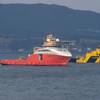Six Coastal States Share $65 Million
The Department of the Interior's Minerals Management Service (MMS) has disbursed $65 million to six coastal states: Alabama, Alaska, California, Louisiana, Mississippi and Texas. This is the fourteenth installment in a series of annual payments based on 1985 settlement legislation regarding the allocation of royalties, rents and bonuses from certain federal offshore oil and gas leases.
The 1978 Outer Continental Shelf (OCS) Lands Act Amendments provided for certain coastal states and the federal government to share revenues earned from OCS leases, generally, three to six miles beyond a state's coastal boundary. This area, known as the 8(g) zone, is named after the enabling paragraph of that legislation. Between 1978 and 1986, revenues earned in the 8(g) zone were placed in escrow, pending agreement on a formula for dividing those earnings.
In 1986, the U.S. Congress determined coastal states would receive 27 percent of the 8(g) income held in escrow, with the remaining 73 percent going to the federal government. At that time, the escrow account contained about $6 billion, about $1.5 billion of which was paid to the states. The remaining $4.5 billion went into the U.S. Treasury General Fund.
The settlement also identified an additional $650 million to be paid to the states, incrementally, over a 15-year period: three percent of their share for each of the first five years, seven percent annually for the second five years, and ten percent annually for the final five years.
Now in their "ten percent years" of the agreement, the states receive $65 million annually.
Petronius Platform Installation Completed
Texaco has successfully installed the second deck module of its Petronius compliant tower platform offshore in the Gulf of Mexico. The installation contractor Saipem lifted the 3,850-ton deck module and set it on the existing tower. The $500 million project stands in 1,754 ft. of water, measuring more than 2,000 ft. tall above the seafloor.
The Petronius compliant tower structure is located in Viosca Knoll Block 786, about 130 miles southeast of New Orleans. The installation of this second deck module represents a key milestone in bringing this significant deepwater discovery to production.
The Petronius platform has maximum production capacity of 60,000 barrels of oil per day and 100 million cu. ft. of gas per day, and is expected to begin production by October 2000.
The Petronius field was discovered in 1995 and contains estimated recoverable reserves of 80-100 million boe. The South Deck Module was built to replace the original module, which was lost during its offshore lift in December 1998. After the incident, Texaco and its partner Marathon assembled a project team tasked with reducing construction time from the original 27-month period.
The replacement module, containing production equipment, waterflood equipment, and crew quarters, was built in 12 months at Gulf Island Fabrication in Houma, La. Saipem's S7000 derrick barge used one of its two 7,700 ton capacity cranes to perform the lift.
ExxonMobil and Agip Announce Venture in Gulf of Mexico
Exxon Mobil Corporation and Eni, the Italian oil and natural gas company, through its subsidiary Agip Petroleum Exploration Co. Inc., have entered into an agreement covering deepwater blocks in the Gulf of Mexico.
Under the agreement, Agip can earn 25 percent of ExxonMobil's interest in up to 259 deepwater blocks by participating in the drilling of a minimum of 12 exploration wells over the next five years.
Luciano Sgubini, COO of Eni's Agip Division, said, "We are very pleased with the conclusion of this agreement which covers approximately 1.3 million net acres and is the largest of its kind to date to be announced in the Gulf of Mexico's deep offshore."
John Cousins, executive vice-president of ExxonMobil Exploration company, said, "The deepwater operating environment is challenging but has the potential to contain large undiscovered accumulations of oil and gas. The combined capabilities of ExxonMobil and Agip will result in a strong partnership to explore this significant potential."
The leases are located on the Outer Continental Shelf offshore Texas, Louisiana, and Mississippi. They extend from Alaminos Canyon to Atwater Valley in water depths ranging from 3,000 to 8,000 ft. ExxonMobil owns 100 percent interest in about two-thirds of the blocks and 50 percent interest in the remainder. Drilling is expected to commence later this year with ExxonMobil as operator.
Edison Chouest Offshore to Invest on Pelican Island
The Board of Trustees of the Galveston Wharves have approved a lease agreement with C Port Galveston, LP/Edison Chouest Offshore (ECO) of Galliano, La., for the development of an $89 million, multi-service terminal on Pelican Island to accommodate the offshore industry.
According to Fred Wichlep, chairman of the Board of Trustees of the Port, "Attracting a major offshore services company to Galveston was one of the Board's top goals for the year 2000, second only to the completion of the Texas Cruise Ship Terminal on Galveston Island in September. With ECO as a port tenant, Galveston becomes the capitol of the exploration and production services industry for the western Gulf of Mexico."
The facility is expected to create between 250-300 jobs for the Galveston work force. The facility will be developed in two phases. The first phase will include land preparation, road access, installation of an export fuel and water system, bulkheading to accommodate initial vendor services and the construction of slip units in groups of three to accommodate customers' commitments. Phase two will add additional on-site vendor services, with possible acquisition of additional property to accommodate other services.
"ECO realized early on that as deepwater drilling assets become available, the industry will move toward the western Gulf of Mexico to explore leases already acquired," said Roger T. White, vice-president, business development for ECO. "ECO made plans to establish a site in the west Gulf, and Galveston was our first choice."
Subscribe for
Maritime Reporter E-News
Maritime Reporter E-News is the maritime industry's largest circulation and most authoritative ENews Service, delivered to your Email five times per week










